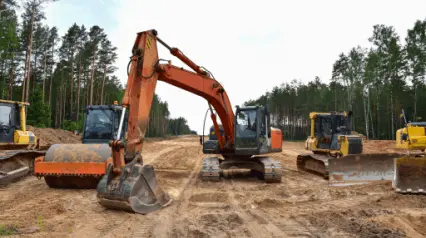What is Land Clearing?
Land clearing refers to the process of uprooting and clearing vegetation to prepare a construction site for a project. This can be done before construction commences to clear the land for laying foundations and increase a property’s value, but it is not a part of regular maintenance and cleaning.
When land clearing is done, teams remove any vegetation and obstructions on the land. This can include trees, plants, rocks, brush, stumps, and anything that gets in the way of the construction project.
Why is Land Clearing Necessary?
In construction projects, land clearing is absolutely necessary before construction can begin. When you purchase land or begin a project on a property, there will likely be many obstacles in the way of building the project. This includes any of the trees, vegetation, and rocks that are on the land which need to be cleared before you can start building.
Clearing the land and removing obstacles allows you to get a better view of the property and make the right decisions on how to commence the project. Without clearing the land, it will be impossible to build a structure that will be stable and stay true to the original design.
Land clearing isn’t just necessary in construction (of structures or roads, for example), as it is also very important in the agriculture industry. The soil loses some of its nutrients over time. So, clearing the land will remove any excess vegetation that’s taking away the nutrients from the soil, making it much easier for new vegetation to grow and thrive in the area.
When is it Necessary?
Land clearing is necessary for most construction and agriculture projects. Before starting an agriculture project, it’s essential to ensure the land is suitable for vegetation and plant growth. To do this, they will need to clear the land so that the seeds they plant will be able to reap all the nutrients available in the soil. That way, they grow faster and healthier.
Additionally, land clearing is necessary before starting construction. When you don’t clear the land, you have many obstacles in the way of the project. This means you won’t be able to establish solid foundations and you might not be able to execute the project according to its original land use plan.
So, before beginning an agriculture or construction project, keep in mind that land clearing is a necessary process. That way, you can ensure that the land is in the best condition possible for the project and everything will run smoothly once you start.
Types of Land Clearing Techniques
Different projects require different land-clearing methods. Teams can use multiple techniques when clearing the land to achieve the best possible results. Below are some of the most common methods used for land clearing and preparing a site for a construction or agriculture project.
Bulldozing
As the name suggests, this involves using a bulldozer to remove any and all obstructions on the land. This is also called the pushover method, as it pushes large amounts of plant growth and vegetation out of the way. And while this is a quick and relatively easy method of land clearing, it keeps the roots intact so the vegetation may be able to grow back after clearing.
Additionally, this method can potentially damage the topsoil. This is why it’s not the most recommended technique for agricultural and large construction projects. However, for small and intermediate construction projects, this could be the ideal technique for clearing the land.
While this method isn’t recommended for all projects, many smaller projects would benefit from this method. This is a relatively quick and easy land-clearing technique, as it requires only a bulldozer and won’t take as much work as other techniques.
Cut and Grind
If you’re working on a property with fewer trees and vegetation, the cut-and-grind method may be ideal for you. As you might tell by the name, this method involves cutting up and removing the vegetation before turning the vegetation into mulch by grinding them.
Typically, teams can use various tools to remove bushes and vegetation. Depending on the size of the vegetation and the property, you may need to use logging tools and equipment such as mulchers, brush mowers, wood plows, and even bulldozers.
Pulling
Also known as the pullover method, the pulling method works in the opposite way as the pushover method. Instead of using a bulldozer to push the vegetation away from the property, this method involves attaching chains to the vegetation and then attaching the chains to a tractor, which will pull off the vegetation and effectively clear the land.
Pile and Burn
The pile and burn method is one of the earliest forms of land clearing popular amongst farmers. This method involves clearing the land, piling everything that you removed, and then burning it. This can be a very cost-effective and quick land-clearing method, but if something goes wrong, you can incur high costs.
For example, if the fires get out of control and damage the property, you will have to conduct fire restorations. Additionally, certain plant materials and vegetation produce hazardous fumes when burned, which could have a negative impact on the environment.
Equipment Needed for Land Clearing
You may have to use various pieces of equipment when clearing the land, depending on the type of vegetation you need to remove, the size of the property, and the exact technique you’re using. However, here are some of the most common pieces of equipment (e.g., light and heavy forestry equipment) and machinery people use for land clearing:




